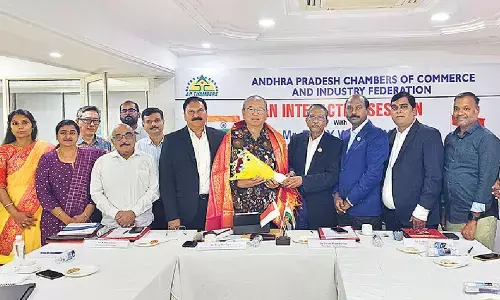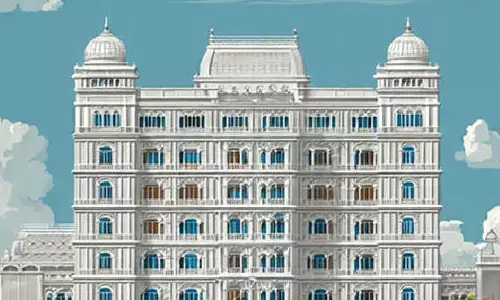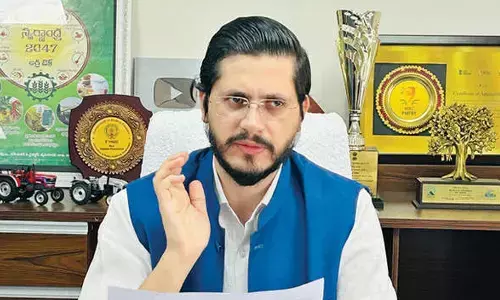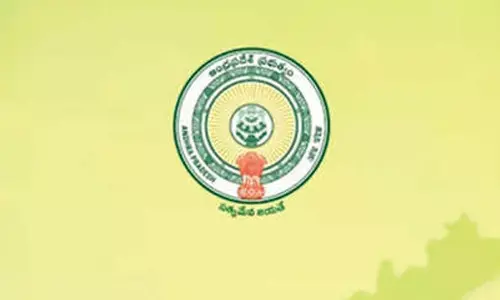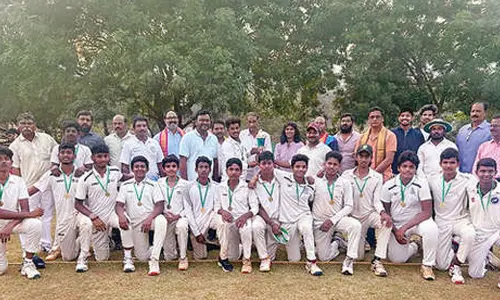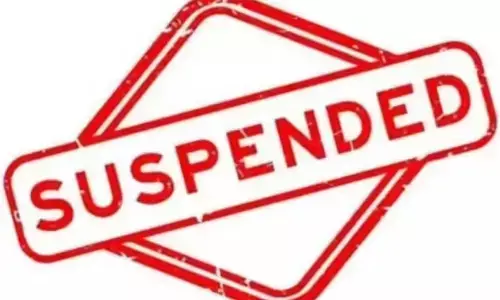What happened at Ayodhya from 1526 to 2024

A festive atmosphere prevailed in the country with Rama Pran Pratishta program to be held in Ayodhya on Monday
Hyderabad: January 22, is a day to remember across the country. As for that, it is a day that will remain forever in the pages of history. A festive atmosphere prevailed in the country with Rama Pran Pratishta program to be held in Ayodhya on Monday. Thousands of people from all over the country have already reached Ayodhya to witness this ceremony. Why is the original Ayodhya Rama temple important? Let's take a look at the history of Sri Rama Chandramurthy who is going to be worshiped again in Ayodhya where Rama walked.
1526: Babar enters India after defeating Ibrahim Lodi at the Battle of Panipat. This started the Mughal Empire. One of his generals pleased Babar by building a large mosque in Ayodhya in 1528 during his conquest of North East India and named it Babri Masjid. Hindus were given the freedom to worship outside the mosque.
1528: Babar's commander Mirbaki orders the construction of a mosque on this disputed site. However, the Hindu community claims that this place is the birthplace of Lord Rama and that there is a temple here. Hindus claim that under one of the gopurams of the mosque is the birthplace of Lord Rama.
1529: Mirbaki built this mosque.
1885: Legal dispute over Babri Masjid begins. Mahant Raghubir Das went to court for the first time seeking to build a temple on the land adjacent to the mosque. But this was rejected by Faizabad District Magistrate. After that, Raghubir Das filed a title suit in the Faizabad Court against the Secretary of India seeking permission to build a temple on the premises of the mosque (Chabutra). Even then he was disappointed.
1949: An idol of Lord Rama was found inside the mosque on the night of December 22. However, there is also an argument that the idol was placed in the mosque overnight. Hindus started offering prayers when the idol of Rama appeared. As a result, the government declared the area as a 'contested area' and locked the entry.
1950: Another claim was made from the side of Hindus. Gopal Shimla Viharad, Paramahamsa Ramachandradas filed a suit in the Faizabad court and asked to be allowed to worship Lord Rama. The court agreed to close the gates of the inner courtyard of the mosque.
1959: Nirmohi Akhada filed a third suit seeking possession of the mosque land.
1961: UP Sunni Waqf Board files suit seeking possession of Babri Masjid site. Also, it demanded removal of idols of Lord Rama from the mosque.
1984: The Ramjanmabhoomi Movement started. Vishwa Hindu Parishad (VHP) has formed a team for this. BJP has appointed senior leader LK Advani as its campaign chief.
1986 (February 1): The inner gate of the Babri Masjid was opened. However, third party advocate UC Pandey asked the Faizabad Sessions Court to open the gates. However, Faizabad district administration ordered to close the gates.
1989 (November 9): VHP was given permission by the then Prime Minister Rajiv Gandhi to lay the foundation stone in the disputed area.
1989: All title suits transferred to Allahabad High Court. Another suit was filed in the High Court in the name of Ramlalla Virajman naming the Nirmohi Akhada in 1959 and the Sunni Waqf Board in 1961 as defendants in the suits.
1990 (September 25): LK Advani started a Rath Yatra from Somnath in Gujarat to Ayodhya in UP seeking support for the temple movement. This led to sectarian violence.
1992 (December 6): Karasevaks who reached Ayodhya from all over the country destroyed the Babri Masjid.
1992 (December 16): Ten days after the demolition of the mosque, the then prime minister constituted a commission headed by retired High Court judge Justice MS Liberhan. He was directed to submit a report on this within three months.
1993 (January 7): Ayodhya land was taken over by the government. The Central government headed by PV Narasimha Rao issued an ordinance declaring that 67.7 acres of land (the mosque site and surrounding areas) had been acquired. After that it became legal.
1993 (April 3): Ismail Farooqui and others filed writ petitions in the Allahabad High Court challenging various aspects of the Act. The Supreme Court in exercise of its jurisdiction under Article 139A transferred the writ petitions pending in the High Court.
1994: The Supreme Court upheld the government's acquisition of the Ayodhya site by a 3:2 majority. It concluded that praying in a mosque is not an integral part of Islam unless there is some significance. However, this judgment has been criticized.
2002 (April): Ayodhya title dispute case resumed. The Lucknow bench of the Allahabad High Court has started the trial of the case.
2003 (March-August): Archaeological survey of the land under the disputed site was started on the orders of the Allahabad High Court. On this occasion, the remains of a 10th century Hindu temple were found there. However, Muslims questioned the archaeological survey report.
2009 (January 30): After a delay of 17 years, the Liberhan Commission submits its report to the Prime Minister, but its contents are not disclosed.
2010 (September 30): The Allahabad High Court ruled that the land of Ayodhya should be divided into three parts and distributed to three parties. It distributed one part to Sunni Waqf Board, another part to Nirmohi Akhada and another part to Ramlalla Virajman.
2011 (May): The Supreme Court stayed the judgment of the Allahabad High Court. The Supreme Court accepted the batch of petitions filed by all the parties. It questioned how the decree could be passed when neither party sought for partition.
2017 (March 21): Former CJ Khehar suggested that all parties should discuss together outside the court.
2017 (August 11): A three-judge bench of the Supreme Court resumed the trial.
2018 (February-July): The petitioners sought a reference to a seven-judge constitution bench for a review of the 1994 Ismail Farooqui judgment.
2018 (July 20): The Supreme Court reserved judgment on the appeal to refer it to a wider bench.
2018 (September 2): Supreme Court refuses to constitute a larger bench. A three-judge bench ruled 2:1 that the 1994 Ismail Farooqui judgment did not need to be reviewed.
2019 (January 8): CJI Justice Ranjan Gogoi constituted a five-judge Constitution Bench.
2019 (March 8): Supreme Court orders arbitration. After a two-day hearing, the Constitution Bench ordered the mediation under the court's supervision, despite objections from some key parties.
2019 (December 12): The Supreme Court dismissed petitions seeking review of the Ayodhya land dispute verdict as lacking any merit.
2020 (February 5): The Union Cabinet approves the formation of the Sri Ram Janmabhoomi Tirtha Kshetra Trust to oversee the construction of the Ram Mandir at the disputed site. Prime Minister Modi announced this in the Lok Sabha.
2020 (February 24): The Uttar Pradesh Sunni Central Waqf Board has agreed to take five acres of land allotted by the state government to build a mosque in Dhanipur village of Sohawal tehsil, Ayodhya.
2020 (March 25): After 28 years Ram Lalla idols were shifted from temporary temple to fiber temple. The foundation stone of the temple was laid on August 5.
2020 (August 5): Prime Minister Narendra Modi laid the foundation stone for the construction of Ram Temple. The trust said that they would complete the construction within six months or a year.
2023 (October 25): Prime Minister Modi is invited by the Ram Janmabhoomi Trust to inaugurate the Ram Mandir.
2024 (January 22): UP CM Yogi Adityanath, Governor Anandiben Patel, RSS chief Mohan Bhagwat will visit the sanctum sanctorum along with Prime Minister Modi and oversee the puja activities. 7 thousand people were invited to the Prana Pratishtha program. Among them are many politicians, religious leaders, celebrities and priests.
2024 (January 22): So far only the first phase of temple construction has been completed. It has two sanctuaries. A five-year-old 51-inch Ram Lalla statue designed by Karnataka-based sculptor Arun Yogiraj will be installed and consecrated. The second phase of the temple is under construction. It has been decided to complete the ground floor and two-storied and five mandapams by the end of this year. The idols of Sita Devi, Hanuman and Lakshmana are enshrined on the first floor of the temple.









